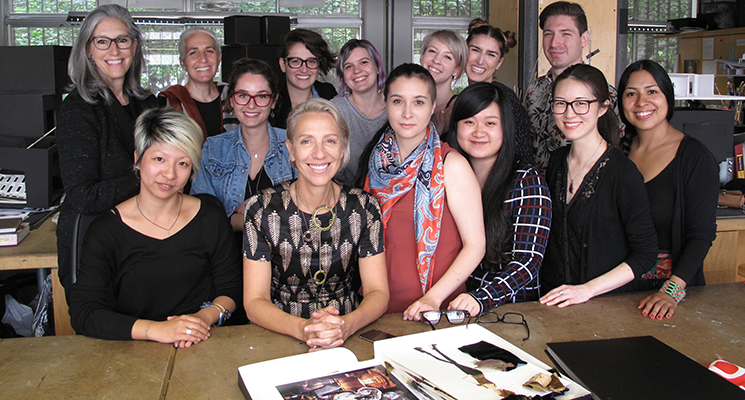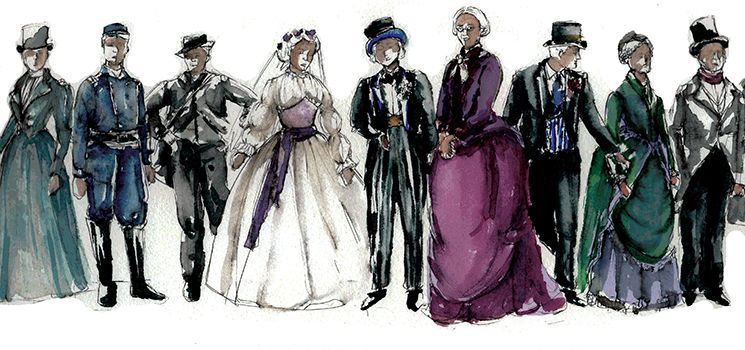News

Visual Storytellers
Putting the spotlight on the UCLA TFT MFA Costume Design program
By Noela Hueso
When Ruth Araujo was deciding what graduate costume design program to attend, she had her pick of schools. The Fulbright scholar from Mexico City had been accepted into every institution she applied to including Carnegie Mellon University and California Institute of the Arts, but in the end, she chose to get her MFA at the UCLA School of Theater, Film and Television (UCLA TFT).
“It was definitely the best match for what I wanted,” says Araujo, who received her degree this past June. “The teachers at UCLA are all actively working in the industry so it felt like the place where I could definitely get a lot more experience. I really liked that at UCLA the emphasis was more on film and TV…and that the teachers were experienced in that area.”
And then some. The current costume design program at UCLA TFT has been passionately built by Emmy Award-winning costume designer Chrisi Karvonides (American Dreams) and Academy Award-nominated costume designer Deborah Nadoolman Landis (Coming to America). Since they joined TFT nearly 11 and 13 years ago, respectively, the two professors have tapped their deep Hollywood connections to come in and share knowledge with UCLA TFT students in dynamic educational offerings and have created a curriculum that is producing what promises to be the next generation of A-list designers in Hollywood and beyond.
“Our students are the beneficiaries of this accumulated experience that Chrisi and I have, and I think that’s really unique among programs,” says Landis, who is also the founding director of the David C. Copley Center for Costume Design at UCLA. “Because it’s not just that Chrisi facilitates this bridge between UCLA and professional life, it’s not just that; it’s the way in which it’s facilitated. This is literally one generation passing to another generation, not secrets, but mentorship on the most concrete and visible level.”
And for those students who are not Fulbright scholars such as Araujo, the cost to attend TFT is competitive. Available teaching assistantships and scholarships help ease the burden as well.
The three-year MFA program, which also provides practical training for stage and opera, is deliberately small — just five students are admitted each year, providing students the opportunity to work alongside professionals and to learn at the highest level. They are set up for success from day one with unparalleled courses taught by Karvonides, Landis and a team of expert adjunct faculty that includes, among others, Alex Jaeger, who has more than 100 stage costume design credits on his resume; and fashion illustrator Aasha Ramdeen, who teaches life drawing, costume digital rendering and design portfolio classes.
Then there are exciting masterclasses such as the one taking place this fall quarter that spotlights the superhero costumes in the Disney+/Marvel miniseries WandaVision, designed by Academy Award-nominated costume designer Mayes Rubeo; a new winter quarter class that centers on creating a pitch package for studios, taught in collaboration with the Department of Film, Television and Digital Media; and a signature Designer-in-Residence course led by Landis that routinely invites expert designers such as Kym Barrett (US), Ruth E. Carter (Black Panther) and Arianne Phillips (Don’t Worry Darling), among others, to impart their wisdom. In that class, students study a film or TV series for which the designer in residence conceived costumes and create their own interpretations.
“[The films are] usually period pieces, so we would do a ton of research on the time period in which they’re based and go really deep into everything,” Araujo recalls of her time in the class. “Not only fashion but what was happening in the world politically, socially and economically; then we’d go into actually designing and talking to the designer. Sometimes we even got notes from the designer. Arianne Phillips told me, ‘I wish I had thought about those things that you just mentioned when I did the movie.’ That was really fulfilling.”
The costume design curriculum is further enhanced by offerings in scenic design, production design for film and lighting design; training in Photoshop, Illustrator and Procreate; 3D rendering for costumes (especially those for action heroes); costume production management, budgeting and construction; and much more. In their first year, students assist in the costume designing for TFT’s in-house stage productions and students’ short films.
“In their second year they do a lot of the new play festival-type plays,” Karvonides says, “and in their third year, they get a mainstage production in which they are specifically wearing the hat of designer while our professional costume shop staff make all their costumes.”
For undergraduate costume designers, the approach is different. While 70% of their education is focused on core liberal arts classes, the remaining 30% is “a very heavy foundation in costume management classes, skills classes, costume construction and design classes,” Karvonides says, adding that undergraduates are encouraged to pursue their MFAs, where they will get hands-on practical experience designing shows. “Some come to back to UCLA, but we prefer to push them out to hear other voices and to diversify their training.”
The program is also producing graduates who are going on to earn historical Ph.D. degrees in costume design, which Landis, a Ph.D. herself, says is “very rare indeed.”


So, what does it take to become a successful costume designer at any level?
“The number one quality that we don't talk about enough is just the ability to work hard and to work long hours,” Landis says. “It’s really an endurance test; you have to be a triathlete in order to be a costume designer.”
In terms of what she wants to see in a prospective student, Landis says that she looks for “intelligence and someone who can communicate, someone who already has cultural literacy, is well educated, and who understands that costume design is hard work. Unfortunately, costume design does not serve shy people, so if you're too shy, it’s not a good prognosis for success in the field.”
Karvonides agrees. “We constantly sell our ideas as costume designers,” she says. “They need to be visual as well as narrative communicators, but that doesn’t mean that we’re looking for all fine artists. Each year, we have a mix of students in our graduate program; some come with a fine arts background, some don’t have that but they’re incredibly organized and can take complex problems, solve them simply and make them happen. So, we take that mix. Then we train everyone to get to a place of visually communicating their ideas. It can be photo bashing, it can be digital rendering; anything goes, as long as they can convey and sell their ideas, because we’re modeling what is expected of designers when they’re working professionally.”
For those graduating from the UCLA TFT costume design program, the bridge from student life to professional life is routinely facilitated by Karvonides and Landis, thanks to their industry relationships, in the form of concrete, entry-level job opportunities.
“We have about 90% job placement for our undergraduates and almost 100% placement in film and television for our graduates within several months of graduating from UCLA TFT,” says Karvonides, who also regularly hires both current students and alumni on her professional productions.
Araujo counts herself in that statistic. She’s currently working as a production assistant in the costume department of Francis Ford Coppola’s next film, Megalopolis, starring Adam Driver, Shia LaBeouf and Aubrey Plaza.
“Chrisi and Deborah have so many costume contacts in the industry,” Araujo says, recalling how she learned about the job. “Chrisi called me and asked, ‘Hey, do you want to work on a Francis Coppola movie?’ and I said, ‘Yeah, I’ll do that!’”
Says Landis: “The best advertisement for our program is that our colleagues know that when they hire one of our students, they can be sure that they’re getting someone who knows how to work and who are well trained. They can trust that they’re getting the best of the best.”
When it comes to landing actual costume designer roles, that becomes even easier once young designers have built their resume and join the Costume Designers Guild Local 892 (of which Landis is a prior president and current Executive Board member) and the Motion Picture Costumers Local 705. In addition to the employment aspect, the unions help guarantee fair wages and work hours, safe conditions and health and pension benefits. Thanks to the skills that TFT students are graduating with, Karvonides says, they’re getting into the unions sooner than expected.
“It used to take three or four years of working as a production assistant before our alumni worked their way into the film and TV unions; now it’s anywhere from four to 18 months,” she asserts. “The reason they're getting into the union so fast is because we have trained them at TFT to be able to work in this crazy business; they’ve been prepped to have the stamina.”


Photos: (from top) Deborah Landis and Chrisi Karvonides (left) pose with MFA students and Designer in Residence Michele Clapton (Game of Thrones) in 2014; (middle) sketches by alumna Madison Carroll (MFA ’19) for the opera The Mother of Us All; costume designer Mark Bridges (Phantom Thread) discusses his career with Landis.

Posted: December 5, 2022





